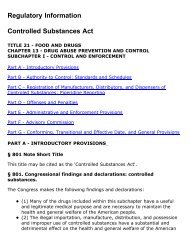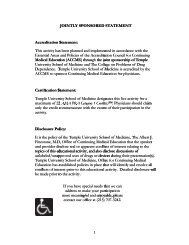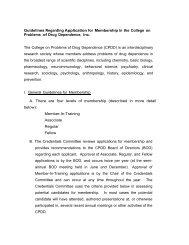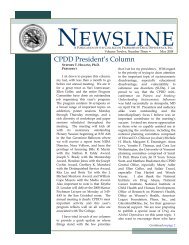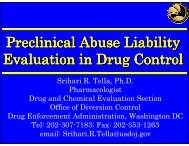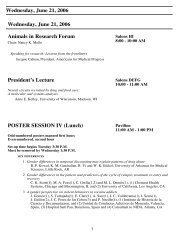CPDD 72nd Annual Meeting • Scottsdale, Arizona - The College on ...
CPDD 72nd Annual Meeting • Scottsdale, Arizona - The College on ...
CPDD 72nd Annual Meeting • Scottsdale, Arizona - The College on ...
Create successful ePaper yourself
Turn your PDF publications into a flip-book with our unique Google optimized e-Paper software.
69<br />
FACTORS ASSOCIATED WITH HIGH VS. LOW USE OF<br />
EVIDENCE-BASED PRACTICES IN ADDICTION<br />
TREATMENT.<br />
Alis<strong>on</strong> Breland 2 , A Fitzgerald 1 ,JMay 1 , F Taxman 3 , D Farrell-Moore 1 ,JR<br />
Koch 2 , D Svikis 2 ; 1 Richm<strong>on</strong>d Behavioral Health Authority, Richm<strong>on</strong>d, VA,<br />
2 Virginia Comm<strong>on</strong>wealth University, Richm<strong>on</strong>d, VA, 3 George Mas<strong>on</strong><br />
University, Fairfax, VA<br />
Aims: Use of evidence-based practices (EBPs) in addicti<strong>on</strong> treatment has produced<br />
positive outcomes, yet implementati<strong>on</strong> gaps remain in community settings.<br />
Researchers and policy makers seek to identify ways to increase the use and<br />
fidelity of EBP implementati<strong>on</strong> in treatment programs. Prior research has<br />
focused <strong>on</strong> implementati<strong>on</strong> issues (Simps<strong>on</strong> et al., 2007), staff motivati<strong>on</strong>,<br />
(McGovern et al., 2004) and factors associated with support for EBPs (Fuller et<br />
al., 2007). Identifying organizati<strong>on</strong>al factors associated with greater EBP use can<br />
inform efforts to promote adopti<strong>on</strong>.<br />
Methods: Staff (N = 68) from treatment facilities in central VA were administered<br />
surveys assessing self-reported use of 32 empirically or c<strong>on</strong>sensus-driven<br />
EBPs, as well as measures of organizati<strong>on</strong>al culture and climate (Lehman et al.,<br />
2002; Taxman et al., 2007). Positive resp<strong>on</strong>ses to EBP use were summed and categorized<br />
using a median split into “high users” and “low users.” Differences<br />
between high and low users <strong>on</strong> organizati<strong>on</strong>al measures were then assessed using<br />
<strong>on</strong>e-way ANOVAs.<br />
Results: Results revealed that high user staff were more likely than low users to<br />
obtain treatment knowledge from a variety of sources, such as professi<strong>on</strong>al development<br />
and membership in professi<strong>on</strong>al associati<strong>on</strong>s (ps < .05). High users were<br />
also more likely to score higher <strong>on</strong> measures of innovati<strong>on</strong> and adaptati<strong>on</strong>, efficacy,<br />
influence, and aut<strong>on</strong>omy. High users also reported having better offices,<br />
more internet use, more positive attitudes toward change, and better training.<br />
C<strong>on</strong>clusi<strong>on</strong>s: Increasing the use of EBPs by SA treatment staff may be better<br />
facilitated by addressing organizati<strong>on</strong>al factors than simply promoting EBPs.<br />
<str<strong>on</strong>g>The</str<strong>on</strong>g>se findings are c<strong>on</strong>sistent with other research indicating that training<br />
resources are associated with the use of EBPs (Friedman et al., 2007) and that, at<br />
an organizati<strong>on</strong>al level, envir<strong>on</strong>mental scanning is associated with use of treatment<br />
innovati<strong>on</strong>s (Roman & Knudsen, 2004).<br />
Financial Support: This research was funded by NIDA R01DA022081-03<br />
71<br />
PHARMACOKINETIC PROPERTIES OF A BACTERIAL<br />
COCAINE ESTERASE TO BE USED AS A TREATMENT<br />
AGAINST COCAINE-INDUCED TOXICITIES.<br />
Remy L Brim, R K Sunahara, J H Woods; Pharmacology, University of<br />
Michigan, Ann Arbor, MI<br />
Aims: In this study we assess the process of eliminati<strong>on</strong> of a bacterial cocaine<br />
esterase (CocE). CocE is rapidly eliminated from the serum of mice with a halflife<br />
of 2.2 hours, thus limiting the in vivo durati<strong>on</strong> of acti<strong>on</strong> of CocE.<br />
Hypothesis: CocE is being eliminated via glomerular filtrati<strong>on</strong>.<br />
Methods: 1) Male Sprague Dawley rats (3 per group) were injected intravenously<br />
with CocE in different 14-day dosing regimens: 8 mg/kg CocE every 4<br />
days, 8 mg/kg CocE daily, or 24 mg/kg CocE every 4 days. Saline c<strong>on</strong>trols were<br />
also included. Six hours following the last dose, rats were sacrificed and perfused<br />
with saline. Kidneys, livers, hearts and lungs were prepared for immunohistochemical<br />
analysis. 2) Male Sprague Dawley rats (3 per time point) were injected<br />
intravenously with 8 mg/kg CocE at 30 minutes and 1, 2, 4, 8, and 12 hours<br />
before intravenous blood sampling and saline perfusi<strong>on</strong>. Kidneys were prepared<br />
for immunohistochemical analysis, additi<strong>on</strong>ally protein was extracted. Kidney<br />
homogenates were analyzed by Western blotting.<br />
Results: 1) No immunoreactivity was found in the liver, heart, or lungs, but was<br />
found in the kidneys, localized to the papilla. Higher immunoreactivity was<br />
observed in animals receiving 24 mg/kg CocE than in those receiving 8 mg/kg.<br />
No significant difference in reactivity was observed between animals receiving 8<br />
mg/kg daily or every 4 days. 2) Peak c<strong>on</strong>centrati<strong>on</strong>s of CocE in the kidney, as<br />
assessed by Western blotting and immunohistochemistry, occurs at 1 hour following<br />
a bolus intravenous dose of 8 mg/kg. Western blot analysis reveals that<br />
full-length CocE disappears in a time-dependent manner after 1 hour, with relatively<br />
few proteolytic fragments detected.<br />
C<strong>on</strong>clusi<strong>on</strong>s: Findings dem<strong>on</strong>strate that CocE is being eliminated through the<br />
kidneys. <str<strong>on</strong>g>The</str<strong>on</strong>g> lack of difference between animals receiving an intravenous dose of<br />
8 mg/kg CocE daily, or <strong>on</strong>ce every 4 days, as well as the rapid loss of reactivity<br />
observed after 1 hour, suggests that CocE is not accumulating in the kidney, but<br />
being rapidly and effectively eliminated from the body.<br />
Financial Support: USPHS grants DA021416, GM007767.<br />
<str<strong>on</strong>g>CPDD</str<strong>on</strong>g> <str<strong>on</strong>g>72nd</str<strong>on</strong>g> <str<strong>on</strong>g>Annual</str<strong>on</strong>g> <str<strong>on</strong>g>Meeting</str<strong>on</strong>g> <str<strong>on</strong>g>•</str<strong>on</strong>g> <str<strong>on</strong>g>Scottsdale</str<strong>on</strong>g>, <str<strong>on</strong>g>Ariz<strong>on</strong>a</str<strong>on</strong>g><br />
18<br />
70<br />
MINDFULNESS TRAINING AND STRESS REACTIVITY IN<br />
SUBSTANCE ABUSE: RESULTS FROM A RANDOMIZED,<br />
CONTROLLED STAGE I PILOT STUDY.<br />
Juds<strong>on</strong> Brewer, R Sinha, J Chen, R Michalsen, T Babuscio, C Nich, A Greer, K<br />
Bergquist, D Reis, M Potenza, K Carroll, B Rounsaville; Psychiatry, Yale<br />
University School of Medicine, West Haven, CT<br />
Aims: Addicti<strong>on</strong>s are major chr<strong>on</strong>ic and public health problems for which few<br />
effective treatments exist. Stress has been shown to play a major c<strong>on</strong>tributory role<br />
in substance use and relapse. Mindfulness training (MT) has shown promise in<br />
a number of stress-related maladies. However, no prior studies have compared<br />
mindfulness training to empirically-validated treatments for substance use disorders<br />
or assessed its impact <strong>on</strong> stress provocati<strong>on</strong> in individuals with addicti<strong>on</strong>s.<br />
Methods: Thirty-six treatment-seeking individuals with alcohol and/or cocaine<br />
use disorders were randomly assigned to receive manualized MT or cognitive<br />
behavioral therapy (CBT) in an outpatient community setting. After treatment,<br />
psychological and physiological resp<strong>on</strong>ses to pers<strong>on</strong>alized stress provocati<strong>on</strong><br />
were measured by self-report, skin c<strong>on</strong>ductance, heart rate, and heart rate variability.<br />
<str<strong>on</strong>g>The</str<strong>on</strong>g> primary outcomes were number of days of substance use and stress<br />
reactivity.<br />
Results: Individuals assigned to MT showed equivalent abstinence to those<br />
assigned to CBT. Additi<strong>on</strong>ally, they dem<strong>on</strong>strated reduced psychological anxiety,<br />
and reduced physiological indices of stress during provocati<strong>on</strong>.<br />
C<strong>on</strong>clusi<strong>on</strong>s: This pilot study suggests that mindfulness training may be efficacious<br />
as a treatment for substance use disorders by targeting a critical comp<strong>on</strong>ent<br />
of addicti<strong>on</strong>s: stress.<br />
Financial Support: NIDA K12-DA00167 (JAB), P50-DA09241 (BJR), R37-<br />
DA15969 (KMC), T32-DA007238 (JAB), K05-DA00457 (KMC), K05-<br />
DA00089 (BJR), P50-DA16556 (RS), K02-DA17232 (RS), R01 DA020908<br />
(MNP), RL1 AA017539 (MNP), the U.S. Veterans Affairs New England Mental<br />
Illness Research, Educati<strong>on</strong>, and Clinical Center (MIRECC) (BJR), and a Varela<br />
grant from the Mind and Life Institute (JAB).<br />
72<br />
FEASIBILITY AND EFFECTIVENESS OF COMPUTER-BASED<br />
THERAPY IN A COMMUNITY-BASED PROGRAM.<br />
Adam C Brooks, D Ryder, D Carise, K Kirby; Treatment Research Institute,<br />
Philadelphia, PA<br />
Aims: Computerized and web-based therapy approaches may expand the reach<br />
of evidence-based substance abuse treatment; however, it is unclear how webbased<br />
therapies can be optimally integrated into community-based treatment<br />
and how effective they will be if they are <strong>on</strong>ly partially implemented. We c<strong>on</strong>ducted<br />
a two-phase pilot study to explore 1) whether client use of the<br />
<str<strong>on</strong>g>The</str<strong>on</strong>g>rapeutic Educati<strong>on</strong> System (TES), a web-based Community Reinforcement<br />
Approach learning program, would benefit clients in the absence of counselor<br />
support, and 2) whether counselors and clients would use the TES in the absence<br />
of tangible reinforcement.<br />
Methods: In Phase 1, we randomly assigned 28 cocaine-dependent clients in<br />
intensive outpatient treatment to receive either 8 weeks of 1) treatment-as-usual<br />
plus cash incentives for completing computerized behavior therapy modules<br />
(TES), or 2) treatment-as-usual plus incentives yoked to the performance of a<br />
patient in the experimental group, with no exposure to the TES (YC). We<br />
assessed client knowledge and coping skills acquisiti<strong>on</strong>, as well as urinalysis-verified<br />
cocaine use during and after exposure to the TES.<br />
Results: Clients in the TES c<strong>on</strong>diti<strong>on</strong> dem<strong>on</strong>strated large improvements in<br />
knowledge acquisiti<strong>on</strong> (F (1, 20) = 8.90, p = 0.007; d = 1.05), and small-to-moderate<br />
effects <strong>on</strong> various indices of improved coping skill acquisiti<strong>on</strong>. TES clients<br />
were significantly more likely to select CBT-style coping resp<strong>on</strong>ses (F (1, 20) =<br />
11.95, p = 0.002; d = 1.16). We also detected small, n<strong>on</strong>-significant effects indicating<br />
decreases in frequency and amount of cocaine used during treatment. In<br />
Phase 2, we studied counselor and client use of the TES following brief training,<br />
and found that counselors referred <strong>on</strong>ly around 10% of their caseloads to the<br />
TES, and that without tangible reinforcement, less than 20% of patients engaged<br />
with the TES for more than 2 to 3 visits.<br />
C<strong>on</strong>clusi<strong>on</strong>s: Computer-based therapy approaches are viable to improve community-based<br />
outpatient treatment, but must be integrated with c<strong>on</strong>tingency<br />
management systems to insure engagement.<br />
Financial Support: Comm<strong>on</strong>wealth of Pennsylvania SAP Number 4100042753



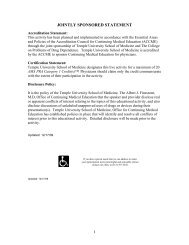
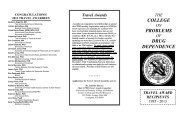
![2013SYMP AND WORKSHOP LIST[web]](https://img.yumpu.com/35325424/1/190x245/2013symp-and-workshop-listweb.jpg?quality=85)
